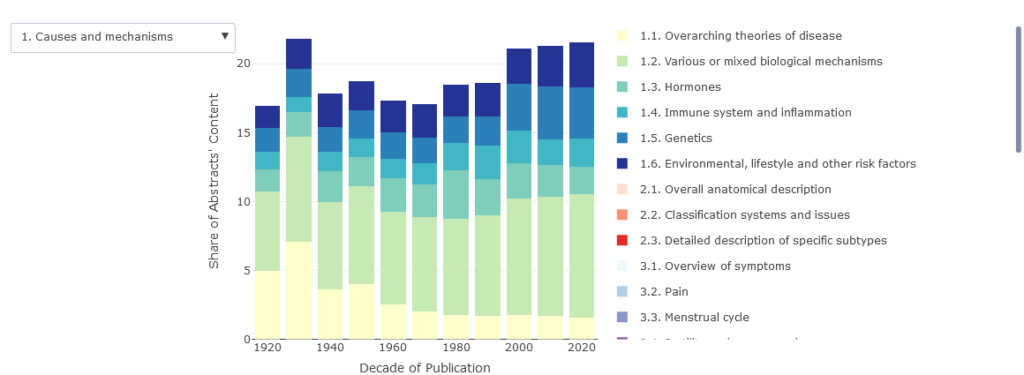In the previous article, I have highlighted the scientific context of endometriosis research, noting an important rise in the number of publications and financial resources dedicated to this disease in recent years. However, it is still challenging to treat endometriosis, and doctors cannot cure it for good. This situation may shock people and patients: what have these scientists been up to if these priorities are not fully tackled yet? (Okay, I am being provocative here, but you understand the idea). In this article, I emphasize what is being done in endometriosis research. I will cover the areas investigated by endometriosis researchers, both in terms of scientific disciplines and topics. As research priorities influence future breakthroughs, these aspects should be of high interest to patients and the wider public.
Graphs may not be fully visible on cell phones. Using a computer is recommended for the best reading experience. The titles can be clicked to get a fullscreen version of the graphs.
Does biomedicine rule alone?
Not surprisingly, the scientific disciplines that are the most active in investigating endometriosis are biology and medicine. It has been the case since the 1920s, when biomedicine represented 100% of endometriosis publications. However, it still holds today. Indeed, in the 2010s and 2020s, more than 98% of endometriosis-related publications can be considered as belonging to biomedicine. However, there has been a clear trend in increasing disciplinary variety in endometriosis research over the years. For instance, in the 2020s, about 4.8% of publications involved psychological sciences1This rise is not linked to a return of the “psychologization” of endometriosis, but rather on a greater emphasis on quality of life and daily experience of patients., 1.4% human society studies or 3.4% chemical sciences. Other scientific disciplines remain a tiny minority.
Biomedicine rules supreme over endometriosis research, but with an increasing disciplinary diversity

Note: Graph based on the full dataset of 36,929 endometriosis-related publications obtained from Dimensions. Disciplines reviewed manually. A publication can belong to one than more discipline, explaining while the total is greater than 100%.
These changes are relevant since the medical sciences cannot tackle endometriosis alone. The perspectives from the social sciences and other natural sciences are also necessary (e.g., to improve care quality, understand the lived experiences of patients, and criticize the dominant approaches…). Moreover, these statistics probably underestimate the actual number of publications outside biomedicine. Indeed, other disciplines may not use the term “endometriosis” as such. For instance, some sociological papers could cover gynecological diseases, menstrual health or other issues linked to endometriosis without explicit reference to a specific illness.
The bulk of endometriosis research is moving away from being the sole realm of medicine, but what about the “top” publications? Indeed, not all scientific papers are created equal (in terms of quality, relevance, visibility…). Identifying the “best” publications is often equated to their number of citations, that is to say, how many times they are quoted by other research. There are some issues with equating citations with quality. For example, some works are cited because they are criticized, some research is used without being mentioned. Moreover, citations can easily be manipulated strategically. But in our case, we can interpret the most cited publications as those that are the most visible among researchers. This metric is thus relevant to take a grasp as the most influential endometriosis research.
Looking at the top 10% most cited publications, the essential facts hold. Biomedicine largely dominates the picture, but with a rising share of other disciplines. Moreover, there is an exacerbation of this disciplinary diversity in the most cited publications. So, the trends seem to be confirmed even for the most visible publications. It is very positive since the contrary could have meant that this diversification was downplayed/ignored by the most influential stakeholders in the field, notably medical doctors.
Even higher disciplinary diversity among the most cited endometriosis publications

Note: Graph based on the sample of 3,560 endometriosis-related publications that are in the top decile of citations for each decade. Disciplines reviewed manually.
The logical consequence of these patterns is the massive development in the multidisciplinarity of publications, that is to say, a rise in the number of papers involving more than one scientific discipline. Before the 1980s, mono-disciplinarity was usually the norm. Afterwards, publications have become much more transdisciplinary, especially among the most cited ones.
Rising multidisciplinarity among endometriosis publications, especially the top ones

Note: Graph based on the full dataset of 36,929 endometriosis-related publications obtained from Dimensions and on the sample of 3,560 endometriosis-related publications that are in the top decile of citations for each decade
I assume that these trends are associated with increased cooperation between researchers from different disciplines. However, this trend is also partly explainable by the fact that medical doctors publish outside the traditional boundaries of their expertise (e.g., psychology) – which could lead to quality issues. Overall, I am still confident that this is a positive development.

What is endometriosis research truly about?
approach than looking at scientific disciplines. Most of the scientific papers available in the database have an abstract, i.e., a short text summarizing their full content. Based on this information and assuming that the abstracts are representative of the publications’ key messages, it is possible to identify “topics” in the endometriosis literature. Topics are defined by specific words occurring together and matched by a specific algorithm (LDA – Latent Dirichlet allocation). On this basis, 325 individual topics were identified in the endometriosis literature. After removing irrelevant categories, they were grouped into eight broad topics, themselves divided into 31 detailed topics. These topics are described in the slider below (click here for a fullscreen version). The titles of the slides correspond to the broad topics, and the icons represent the detailed topics falling under each broad topic. Every element is clickable to obtain further information on the topics’ content.
Topics of endometriosis research

The scientific publications can contribute to one or more of these topics, allowing us to track the research priorities of the endometriosis literature over time.
Trends in broad research priorities in the endometriosis scientific literature

Note: Graph based on a sample of 28,521 publications with an available abstract
In terms of broad research priorities, the endometriosis literature is dominated by research focusing on the “causes and mechanisms” of the disease (21.3% of the abstracts’ content in the 2010s) and potential “treatment” (18.95%). Four broad topics benefit from a slightly lower and comparable level of effort: “anatomy and classification” (11.77%), “diagnosis and analyses” (10.63%), “symptoms and daily life” (10.23%) and “connections to other diseases” (9.88%). The remaining topics are much more marginal, with “health and economic burden” and “miscellaneous” topics representing 1.47% and 0.56% of the 2010s content, respectively. Notable trends are the relative decline of “anatomy and classification” and “connections to other diseases” over time. By contrast, attention to “causes and mechanisms” and “treatment” has tended to increase overall, even though there are some oscillations. The patterns for the relative importance of each broad topic are very similar when focusing on the most cited publications only, even if their evolution over time is less clear-cut.
Similarly, the interactive graph below allows you to explore the specific topics and their respective trends.
Evolution of detailed research priorities in the endometriosis literature

Note: Graph based on a sample of 28,521 publications with an available abstract. Click here for the top 10% most cited publications.

Pain or Fertility?
As already mentioned, the “canonical” symptoms of endometriosis are pain and infertility. Many women affected by the disease also report that in practice, medical practitioners can prioritize fertility over quality of life or pain relief, sometimes without consulting their preferences2See for instance https://academic.oup.com/humrep/article/31/3/554/2384761. This behavior can result from multiple causes, including unchallenged assumptions from doctors (e.g., on what women want/are expected to want), difficulties in treating other aspects, lack of training/habits… But this is observed in healthcare: does this issue occur at the research level as well? If so, this could partly explain the experience of some women. It would hint that a rebalance of the research priorities could be beneficial. Of course, it is crucial to keep in mind that such a rebalancing would not be the only – or even the primary – lever to action to address this issue.
Thanks to the topics identified in this article, we can try to estimate the level of effort that is dedicated explicitly to either pain or infertility. The relevant research is indeed not restricted to the topics identified in the “symptoms” broad topic, but also include parts of treatments, etc. Fortunately, we can regroup the relevant research into coherent categories. A major caveat that should be kept in mind with this approach is that some research is targeting BOTH pain and infertility. But by looking at the research specifically dedicated to these issues, I still think that we can have a good idea of the level of prioritization of these concerns. The following graph compares the weight of both themes in endometriosis publications over time.
Fertility benefits from a higher level of attention than pain in endometriosis research

Note: Graph based on a sample of 28,521 publications with an available abstract. Research specifically focusing on pain include: Chronic Pelvic Pain; Chronic Pelvic Pain experience and analgesia; Menstrual, sexual and intestinal pain; Nerve-related aspects of pain (focus sciatic, pelvic, utero-sacral…); Nervous/biological aspects of pain; Pain evaluation (score, scale…); Rat model (stress, pain and physical activity); Pharmaceutical drugs (elagolix…) oriented towards work/pain; Nerve-centred surgery for pelvic pain /// research specifically focusing on fertility include: Explanations of infertility vs fertility (e.g., genetic, immunological…); Factors for infertility (male and couple-focus); Follicular fluid and oocytes; Implantation window, outcomes; Issues regarding Embryo development (focus on early stages ; mechanisms, analyses…); Ovarian reserve and related hormonal/anatomical features; Physiological processes of reproductive function; Pregnancy outcomes; Pregnancy outcomes (rates, miscarriages); Sperm/Semen and fertility; Subfertility in minimum to mild endometriosis; Fertility preservation; Fertility treatment (intrauterine insemination); IVF and its outcomes; IVF and its outcomes (focus on oocytes , embryo transfer); Ovarian stimulation; Reproduction Assistance Technologies
As you can see from this graph, it is evident that the scientific literature dedicated to endometriosis pays much more vigorous attention to fertility than pain. It has been the case for a long time and still holds for recent years, even though the gap trends to shrink. For instance, in the 2010s, there was about 1.8 times more research specifically dedicated to fertility than to pain, but this ratio has declined to 1.6 in the 2020s (partial data). This pattern is very similar in the most cited publications as well.
Of course, there could be many different explanations for this situation. It could reflect the researchers’ priorities and, to some extent, the patients’ priorities (after all, the overwhelming majority of people want to have children). It could depend on the specialties of the involved researchers: perhaps if more neurologists or psychologists were involved in the research, the focus would shift towards pain? It could mean that it is easier to carry out research on fertility than on pain. Or that funding is more readily available for this topic. Maybe it could be a mere artifact of the methodology, and that pain and infertility are prioritized similarly when taking into account the research that targets both aspects indiscriminately.
Clearly, this finding must be consolidated, but the evidence hints that there could be something at play that is not restricted to healthcare but also to the upstream research – and its priorities.

Treating endometriosis? A focus on clinical trials
However, it is not enough to analyze the endometriosis literature as a whole to grasp current developments. When considering treatments, a specific type of study is relevant, namely clinical trials. In these trials, the goal is primarily to evaluate the effects of interesting interventions (such as a drug, a diagnostic test…) that we think may benefit patients. In that respect, they are more “directly” connected to practical issues than the rest of scientific research. So if we are concerned about the welfare of women with endometriosis, taking a close look at this strand of research is of paramount importance.
The clinicaltrials.gov database of the US National Library of Medicine collects information on many of these trials, including some not carried out in the USA. Based on an extraction performed in October 2021, it is clear that the number of trials started each year for endometriosis has dramatically increased over the last decades.
The recent boom of endometriosis clinical trials

Note: Graph based on an extraction of the 522 studies from the Clinicaltrials.gov database matching the “endometriosis” condition in October 2021
Indeed, in the 1990s, very few trials were even started (or at least recorded in the database). A quick increase can be observed from the 2000s onwards, which mirrors the trend for all scientific publications. In the late 2010s/early 2020s, more than 50 trials were started on a yearly basis. It confirms that there is a consolidating interest in treating the disease, including within companies and universities that may deploy new treatments.
Moreover, the tested interventions in these clinical trials have become much more diversified than in the past.
Increasing diversity of tested interventions in endometriosis clinical trials

Note: Graph based on 417 clinical trials started between 1996 and 2020 and reporting the types of tested interventions. Total can be above 100% since a single trial can test multiple types of interventions.
Early trials tended to focus on drugs and procedures (i.e., surgical interventions). In recent years, the picture is much more fragmented, with a rising interest in evaluating, e.g., diagnostic tests, devices or behavioral (psychological) interventions to tackle endometriosis. This trend is probably connected to the fact that the disease is more visible and studied nowadays.
Moreover, there is also considerable diversity within each type of tested intervention. For instance, the drugs tried in these studies not only include hormonal treatments but also increasingly attempt to test other types of molecules. The increase in trials and their diversity lead us to expect future breakthroughs for endometriosis care. This promise seems to align with some of the key motivations of women participating in endometriosis research3See https://pubmed.ncbi.nlm.nih.gov/17845471/ or https://pubmed.ncbi.nlm.nih.gov/17380055/ for some (preliminary) insights. However, despite the potential of clinical trials, we should remember that the risk of failure is high for such studies (even at late stages). There is hope, but it’s different from selling false hopes too early.
Notes
- 1This rise is not linked to a return of the “psychologization” of endometriosis, but rather on a greater emphasis on quality of life and daily experience of patients.
- 2See for instance https://academic.oup.com/humrep/article/31/3/554/2384761
- 3See https://pubmed.ncbi.nlm.nih.gov/17845471/ or https://pubmed.ncbi.nlm.nih.gov/17380055/ for some (preliminary) insights



